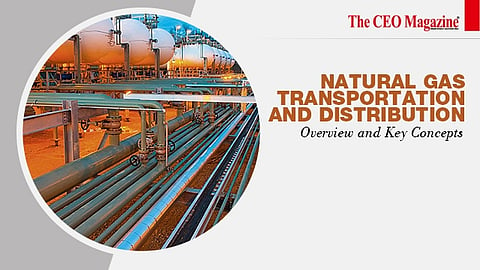
- News
- Women
- Magazine
- IndustryIndustry
- InsightsInsights
- Success Stories
- PublishPublish
- ContactContact
- Media KitMedia Kit

Natural Gas Transportation and Distribution
Natural gas is an essential energy source used for heating, cooking, and electricity generation worldwide. However, natural gas transportation and distribution is a complex process involving various stages and infrastructure.
This article will provide an overview of the key concepts and practices related to natural gas transportation and distribution, including its properties, transmission and distribution pipelines, and safety considerations.
Natural gas is a fossil fuel found in underground reservoirs and extracted using drilling techniques. After extraction, natural gas must be transported to its final destination, which may include residential, commercial, or industrial facilities.
Natural gas transportation and distribution involves a range of infrastructure, including pipelines, storage facilities, and compressor stations.
Natural gas is a colourless and odourless gas that is composed primarily of methane, with small amounts of other hydrocarbons such as ethane, propane, and butane.
Natural gas is a highly combustible, clean-burning fuel that produces lower emissions than other fossil fuels such as coal and oil. However, natural gas is also a potent greenhouse gas and must be handled and transported with care.
Transmission pipelines are the primary means of transporting natural gas over long distances. These pipelines are typically made of steel and can range in diameter from a few inches to several feet. The transmission pipelines are laid underground and span thousands of miles across continents.
Natural gas is transported through the transmission pipelines at high pressure, typically between 200 and 1500 pounds per square inch (psi). The gas is compressed at compressor stations located along the pipeline route to maintain the pressure and ensure that the gas flows smoothly through the pipeline.
Distribution pipelines are used to transport natural gas from the transmission pipelines to residential, commercial, and industrial customers.
These pipelines are typically smaller in diameter than transmission pipelines and operate at lower pressures. Distribution pipelines are often made of plastic or coated steel and are typically laid underground.
Natural gas is delivered to customers through service lines that connect to the distribution pipelines. These service lines are typically made of plastic or steel and are buried underground to prevent damage.
Natural gas is a highly combustible fuel that must be handled and transported carefully. Safety considerations are important to the natural gas transportation and distribution process.
Pipelines must be inspected regularly to detect and repair leaks or other defects that could compromise safety.
In addition, natural gas is odourless, making it difficult to detect leaks. An odorant called mercaptan is added to natural gas before it is transported to address this issue. This gives natural gas a distinct odour that is easily recognisable and can help detect leaks.
Natural gas is an essential energy source used for heating, cooking, and electricity generation worldwide. Natural gas transportation and distribution involves a range of infrastructure, including pipelines, storage facilities, and compressor stations.
Natural gas is transported over long distances through transmission pipelines and distributed to residential, commercial, and industrial customers through distribution pipelines.
Safety considerations are an important part of the natural gas transportation and distribution process, and regular inspections and leak detection are critical to maintaining safety.
Overall, natural gas transportation and distribution is a complex process that is essential to ensuring the availability and reliability of this important energy source.
Follow us on Google News
